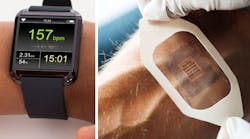Improving Remote Patient Monitoring to Overcome Healthcare Limitations
Download this article in PDF format.
The process of remote patient monitoring has been with us for many years. It’s experienced some success, but this platform also has been fraught with problems and limitations. With today’s technology, it’s now possible to solve those problems, remove those limitations, and make significant advances in this healthcare technique.
The COVID virus has stretched healthcare resources to the limit and that, in turn, has neglected many non-COVID patients. Improved remote patient monitoring is one way to address this problem. Some new products from Maxim Integrated help make it possible.
Sponsored Resources:
- Pandemic Remote Patient Monitoring
- MAX32666 MCU for wireless and battery applications
- MAX77654 PMIC for efficient battery powered applications
The Rationale
Remote patient monitoring is a good way to have your cake and eat it too. It greatly reduces the time, need, and trouble of frequent traveling visits to doctor offices, and allows healthcare professionals to keep track of a patient’s conditions and expedite services quickly as needed.
Patients with conditions like cancer, heart disease, diabetes, kidney disease, and other chronic maladies dominate healthcare services because of the severity of the illnesses. Such patients require constant monitoring to detect problems and help avoid discomfort, suffering, and even death. The incentive to improve healthcare, manage costs, and better serve the patient is to make distance warnings and advisories more available and affordable. The electronic requirements to deliver such services have become more complex and difficult over the years. Yet, modern technology is there to deal with it.
Some of the conditions that can be accurately detected these days are high blood pressure, heart rate, blood-oxygen level, body temperature, and blood-glucose level. Doctors can tell if a serious condition occurs or if a patient is taking his or her medication. Early detection can improve a patient’s condition.
The Apparatus of Remote Monitoring
Remote-monitoring systems consist of accurate sensors for detecting and measuring the conditions to be monitored and the analog front end to amplify, filter, and digitize the sensor data. An embedded controller collects and stores the data, and software analyzes the data to detect selected conditions to be set as alarms. Then a short-range radio sends data to a smartphone for transmission to the selected end point for action. Finally, there’s a battery power supply to run the whole thing.
All of this is packaged in a variety of ways, including wristbands, patches, and rings or headbands. It must be small and light. Two of the most critical design objectives are ease of installation, setup, and use for technology-challenged consumers, and minimized power consumption. All of the sophisticated electronics requires lots of power, necessitating frequency battery replacement or recharging. Minimizing that need requires serious power management.
Addressing this Challenge
One company viewing this problem as an opportunity is Maxim Integrated. Two of its recent products targeting this market are the MAX32666 microcontroller and the MAX77654 power-management integrated circuit (PMIC). Both devices deal with the power-consumption problem while providing other valuable system contributions.
The MAX32666 is a low-power Arm Cortex-M4 microcontroller with floating-point unit (FPU). This device is a system-on-chip with SRAM, flash, caches, I/O, and support features. Here’s a summary of key features:
- Dual Arm Cortex-M4 cores with FPU
- Integrated switch-mode power supply for coin-cell operation
- I/O includes three QSPI master/slaves, three 4-wire UARTs, three I2C master/slaves, and up to 50 GPIOs.
- 8-input, 10-bit delta-sigma ADC
- Six 32-bit timers
- 16 PWM engines
- Memory error correction coding
- Security and encryption unit with AES 128/192/256, DES, 3DES, and a hardware accelerator.
- A fully integrated Bluetooth Low Energy 5 radio with a 2-Mb/s data rate.
Maxim says the MAX32666 is one of a new family of low-power microcontrollers they call DARWIN (see figure). Maxim says, “DARWIN microcontrollers are designed to run any application imaginable in places where a user would not dream of sending other microcontrollers.” Just the kind of device for remote patient monitoring.
Power Management is Essential
The MAX32666 micro is super power-efficient. But even better control of power consumption is a core requirement for a patient-monitoring device. Maxim’s MAX77654 PMIC has this covered. It contains:
- Three programmable buck-boost switch-mode regulators (one inductor)
- Two 100-mA low-dropout regulators (LDOs)
- A Li+/Li-poly battery charger
- Watchdog timer
Other Apps
These two products are available as tiny wafer-level chips that can be built into almost anything, even hearing aids. Medical and fitness wearables, other telemedicine, gaming devices, and other consumer portable devices are good candidates for these devices. A variety of IoT products are also targets for these ICs.
Sponsored Resources:


